Symmetry - Solutions
CBSE Class –VII Mathematics
NCERT Solutions
Chapter 14 Symmetry (Ex. 14.1)
Question 1. Copy the figures with punched holes and find the axes of symmetry for the following:
(a)  (b)
(b) (c)
(c)
(d) (e)
(e)  (f)
(f) 
(g)  (h)
(h) (i)
(i) 
(j)  (k)
(k)  (l)
(l)
Answer: Sol.
| S.No. | Punched holed figures | The axes of symmetry |
| (a) |  |  (rectangle) (rectangle) |
| (b) |  |  |
| (c) |  |  |
| (d) |  |  |
| (e) |  | 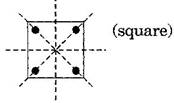 |
| (f) |  |  |
| (g) |  |  |
| (h) |  |  |
| (i) |  |  |
| (j) |  | 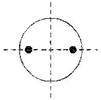 |
| (k) |  |  |
| (l) |  |  |
Question 2. Given the line(s) of symmetry, find the other hole(s):
| S.No. | Line(s) of symmetry | Other holes on figures |
| (a) |  | |
| (b) |  | |
| (c) |  | |
| (d) |  | |
| (e) |  |
Ans.
| S.No. | Line(s) of symmetry | Other holes on figures |
| (a) |  |  |
| (b) |  |  |
| (c) |  |  |
| (d) |  |  |
| (e) |  |  |
Question 3. In the following figures, the mirror line (i.e., the line of symmetry) is given as a dotted line. Complete each figure performing reflection in the dotted (mirror) line. (You might perhaps place a mirror along the dotted line and look into the mirror for the image).
Are you able to recall the name of the figure you complete?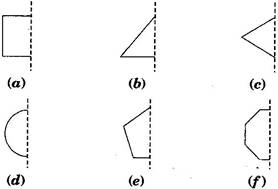
Answer: Sol.
| S.No. | Question figures | Complete figures | Names of the figure |
| (a) |  |  | Square |
| (b) |  |  | Triangle |
| (c) |  |  | Rhombus |
| (d) |  |  | Circle |
| (e) |  |  | Pentagon |
| (f) |  |  | Octagon |
Question 4. The following figures have more than one line of symmetry. Such figures are said to have multiple lines of symmetry: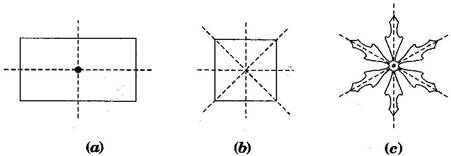
Identify multiple lines of symmetry, if any, in each of the following figures:
Answer:
| S.No. | Problem Figures | Lines of symmetry |
| (a) |  |  |
| (b) |  | 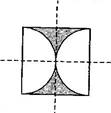 |
| (c) |  |  |
| (d) |  |  |
| (e) |  |  |
| (f) |  |  |
| (g) |  | 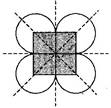 |
| (h) | 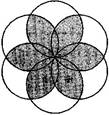 | 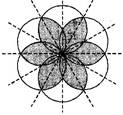 |
Question 5. Copy the figure given here: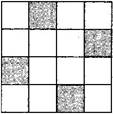
Answer figures are: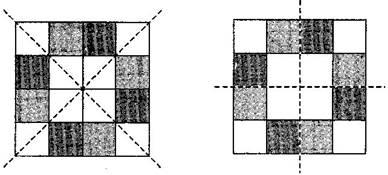
Yes, there is more than one way.
Yes, this figure will be symmetric about both the diagonals.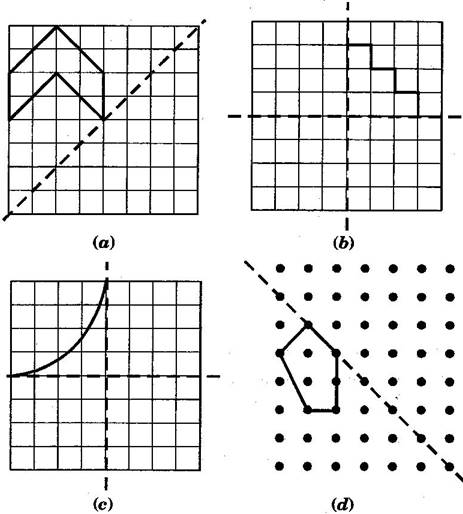
Take any one diagonal as a line of symmetry and shade a few more squares to make the figure symmetric about a diagonal. Is there more than one way to do that? Will the figure be symmetric about both the diagonals?Answer: Question 6. Copy the diagram and complete each shape to be symmetric about the mirror line(s):
Question 6. Copy the diagram and complete each shape to be symmetric about the mirror line (s) :
Answer: 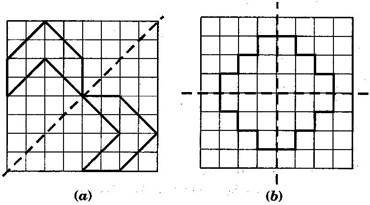

Question 7. State the number of lines of symmetry for the following figures:
(a) An equilateral triangle(b) An isosceles triangle(c) A scalene triangle
(d) A square(e) A rectangle(f) A rhombus
(g) A parallelogram(h) A quadrilateral(i) A regular hexagon
(j) A circle
Answer:
| S.No. | Figure’s name | Diagram with symmetry | Number of lines |
| (a) | Equilateral triangle |  | 3 |
| (b) | Isosceles triangle |  | 1 |
| (c) | Scalene triangle |  | 0 |
| (d) | Square | 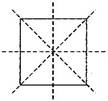 | 4 |
| (e) | Rectangle |  | 2 |
| (f) | Rhombus |  | 2 |
| (g) | Parallelogram |  | 0 |
| (h) | Quadrilateral |  | 0 |
| (i) | Regular Hexagon | 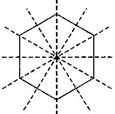 | 6 |
| (j) | Circle | 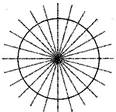 | Infinite |
Question 8. What letters of the English alphabet have reflectional symmetry (i.e., symmetry related to mirror reflection) about:
1. a vertical mirror
2. a horizontal mirror
3. both horizontal and vertical mirrors
Answer: (a) Vertical mirror – A, H, I, M, O, T, U, V, W, X and Y mirror mirror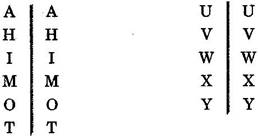
(b) Horizontal mirror – B, C, D, E, H, I, O and X
(c) Both horizontal and vertical mirror – H, I, O and X
Question 9. Give three examples of shapes with no line of symmetry.
Answer: The three examples are:
1. Quadrilateral
2. Scalene triangle
3. Parallelogram
Question 10. What other name can you give to the line of symmetry of:
1. an isosceles triangle?
2. a circle?
Answer: (a) The line of symmetry of an isosceles triangle is median or altitude.
(b) The line of symmetry of a circle is diameter.
